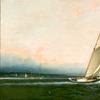Travel Through Time: Asian Art Featured on The Curator’s Eye
- NEW YORK, New York
- /
- September 18, 2013
As Asian art markets continue their impressive showing at sales and shows around the world, The Curator’s Eye (www.CuratorsEye.com) hosts a chronological tour of the exceptional items of Asian origin currently on display on the continuous online exhibition. The Curator’s Eye offers a varied selection of objects made in locations from China to Cambodia, and made from as early as 550 A.D. up to contemporary times.
Chinese Standing Buddha
Dated during the Northern Qi Dynasty of China, which ran between 550 and 577 A.D., this exceptionally beautiful standing Buddha represents the height of Northern Qi Buddhist sculptures in the quality of its carving and elegant restraint. The face of the carving has the unreachable deep meditative expression typical of Buddhist art, and the treatment of the robe has just a few parallels in Northern Qi sculpture, making this a rare example of the art of this period, and how it reflects the influence of Indian Gupta sculptural style.
Baphuon Style Khmer Head
Moving ahead five hundred years, The Curator’s Eye presents a finely sculpted, elegant gray schist carved head, in the style of the Baphuon Temple in Angkor, Cambodia. The temple was built around 1060 under the reign of Udayadityavarma to the glory of Shiva. In this piece, the Baphuon style is exhibited in the characteristic incised lines drawing the eyes and lips, as well as in the dimple in the chin highlighting the purity of the lines combined with the smiling grace.
Japanese Kano School Panels
A set of four Kano school fusuma panels from Japan joins the offering. Made in the 18th Century out of ink, colors, and gold on paper, these panels depict geese beside a stream with a willow tree and a pair of peacocks posed with other flowers beneath a blossoming cherry tree at left. The reverse is painted with a river landscape, the banks lined with blossoming cherry trees and pines while rafts are poled downstream. The panels are signed Kakuchiku with seals San and Tei.
Chinese “Chicken Fat” Glass Bowl
Returning to China at the turn of the 18th/19th Century, one of the most popular items on display on The Curator’s Eye is a translucent “chicken fat” yellow glass bowl. This stunning object is modeled in the form of a large lotus leaf with a scalloped rim folding over the edge of the lotus leaf. The outer wall is carved and incised with a continuous scene of lotus blossoms, leaves and pods, and the stalks of the plant form the elegant foot of the bowl. According to Theresa Bartholomew, a clump of lotus represents “firm roots and luxuriant branches, or May your business have a firm foundation and may it flourish.”
Japanese Edo Period Screens, Meiji Period Tea Service
Moving further through time to 19th century Japan is another set of screens, these six-panel Edo period byobu display gold and silver fans painted with flowers, fruits and other plants, floating over stylized waves bordered by a curving bank lined with reeds bent by the breeze.
The 19th century in Japan saw many changes as the empire opened to the world, and this remarkable silver and enamel tea set from the Meiji period is sure to please the eye and the connoisseur. The set, which is overlaid in coloured cloisonne enamels with iris and wisteria blooms and foliage, is stamped “Musashiya” to the base and engraved on the sides with “Masazane.” Musashiya was the pre-eminent retailer of high-end decorative arts during the Meiji era whose Yokohama branch was established soon after the port opened in 1859. This tea set is one of the splendors of imperial Japan.
Chinese Contemporary Paintings by Zeng Xiaojun and An Ho
Fast forward to contemporary times to round out the selection of available Asian items on The Curator’s Eye. A traditional Chinese brushwork painting titled Mountains and Rocks as Companions, from 1994 by Zeng Xiaojun is one of many contemporary Chinese works on exhibit. In it, the serene and contemplative atmosphere of the painting derives from incorporating a small human figure in the midst of boundless nature, sitting quietly atop a mountain, meditating or paying homage to the large scholar rock that is situated beside him. The first impression of Zeng Xiaojun’s painting is of a vigorous energy evinced by the power of traditional Chinese brushwork. Zeng’s vision and his distinctly personal style arise from mastering with a great strength of character and determination the classical tradition of literati painting and transforming this inheritance into an art that is vital and modern.
At last we come to the most recent work in our selection, a lyrical landscape painting titled Mountains and Trees by An Ho from 2010. An Ho is an outstanding master of Chinese painting who studied with Pu Ru (1896-1963) for 17 years as his student and protégée. An Ho’s landscapes are her own poetical fantasy, part memory, part dream, and have that quality of dreaming that is more perfect than reality. Her scenes achieve nobility by their pure expression of a tranquil understanding of the universe, of the harmony between man and nature. An Ho’s painting keeps alive an artistic tradition threatened by the contemporary world and re-establishes our connection to the natural universe from which it is originally derived.
The Curator’s Eye is the distinctive online platform for the finest art and antiques from distinguished dealers around the world. To view more exceptional Asian art items from eras across time, visit www.CuratorsEye.com.
Contact:
Leah TharpeThe Curator's Eye, LLC
8885995099
leah.tharpe@curatorseye.com
CuratorsEye@gmail.com
888-599-5099
http://www.curatorseye.com
About The Curator's Eye, LLC
A scholarly online exhibition connecting museums, collectors, and dealers with the finest art and antiques available on the market.








_-Closing-the-Distance_100x100_c.jpg)







